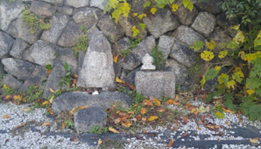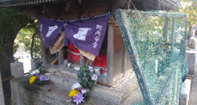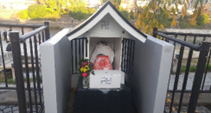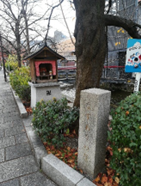Abandoned Jizo-sama
Yoshie Doi
 Abandoned Jizo on the west side of Sanjo Ohashi |
 Jizo statue along the road on the west side of Sanjo Ohashi Bridge |
 An abandoned Jizo statue and a Jizo statue enshrined back to back |
 Nasuari Jizoson |

Jizo statue built into the Nomura Securities Building in Shijo Agaru, Sakaimachi |
Jizo statues are everywhere in Kyoto. No one seems to have counted how many there are, but it is said that there are more than 7,000. There are many Jizo shrines in the Karasuma Shijo neighborhood, but they are cleaned every day, and flowers and sake are offered at New Year’s.
It has been decades since the Jizo statue was abandoned under the Sanjo Ohashi Bridge, and the notice at the Kyoto Prefectural Civil Engineering Office urging the owner of the Jizo statue to remove it became a problem, causing a bit of an uproar.
Fortunately, Zuisenji Temple near the Sanjo Ohashi Bridge decided to take over the property, and the matter was settled. but some people said that the expression “This property is …” about Jizo was insane.
In contrast to the abandoned Jizo, two Jizos are enshrined along the road leading to the Kamo River, which descends from the Sanjo Ohashi Bridge a little further away. Flowers are also offered, and it is a well-maintained shrine.
In addition, there is a small shrine built into the Nomura Securities Building on Sakaimachi-dori, which is located slightly above Shijo-dori, where two Jizo statues are enshrined.
Heading north from Shijo Yamato-oji Street in Gion, there is a jizo statue that was excavated from the bottom of the Shirakawa River near Yusai Bridge in 1954, when the water pipes were being constructed.
It’s about 20 years ago, I was moved to hear a story from a rice shop who take care a Jizo. I don’t know the name or origin, but it seems that it was a jizo that has been hundreds of years old.
In Kyoto, there is a spirit of valuing Jizo like this. An Englishman says that every time he visits Kyoto, he buys one Jizo statue as a souvenir. It is also said that there was an Englishman who bought 100 pieces of Shigaraki raccoon dog pottery and returned home. Do people from other countries understand that souls reside in stones and pottery?
Just like the word kotodama in Japan, there is an idea of Yaoyorozu no Kami (eight million gods) that believes that words have souls and that stones have souls. They believe that God resides in both fire and water. Thinking of the history of the Kamogawa River, I joined hands with the existence of the Jizo statue that was abandoned on Sanjo Ohashi Bridge.
The end of document
